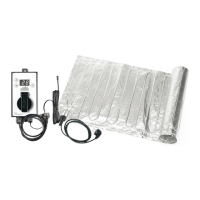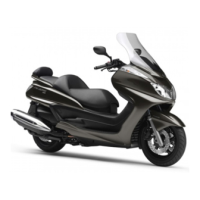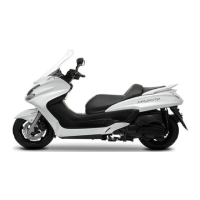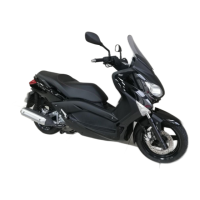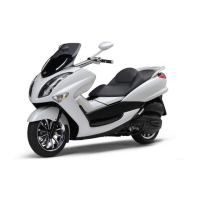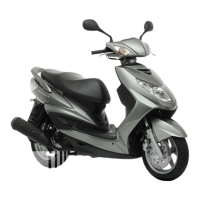Do you have a question about the Yamaha QBIX LTV125 and is the answer not in the manual?
Emphasizes owner's responsibility for safe operation and proper use of the scooter.
Provides guidance on pre-operation checks and safe riding practices.
Details essential protective gear for rider safety, including helmets and clothing.
Warns about the dangers of carbon monoxide and provides precautions for safe ventilation.
Explains the importance of helmets, selection criteria, and correct usage for head injury prevention.
Illustrates and identifies key components and parts on the left side of the scooter.
Illustrates and identifies key components and parts on the right side of the scooter.
Details the location and function of various controls and instruments on the handlebar.
Explains how to operate the smart key system and its functionalities.
Provides guidelines for handling the smart key and mechanical keys safely to prevent damage.
Describes the operation of the main switch for turning power on/off and locking the steering.
Explains how the Stop and Start System works and how to activate/deactivate it.
Provides essential precautions for safe and correct operation of the Stop and Start System.
Explains the features and operation of the remote control unit for locating the vehicle.
Identifies and explains the meaning of various indicator and warning lights on the meter.
Describes the components and displays of the multi-function meter unit.
Details the functions of switches located on the left and right handlebars.
Outlines checks for fuel level, refueling, and fuel line integrity before operation.
Details checking engine oil level, adding oil, and inspecting for oil leakage.
Covers checks for front/rear brake operation, pads/shoes, fluid level, and hoses.
Guides on checking tires for damage, tread depth, air pressure, and wheel condition.
Guides on the procedure for starting the engine, including pre-checks and switch operations.
Provides warnings and techniques for safe and effective braking on various road surfaces.
Explains the critical break-in period for the engine to ensure longevity and performance.
Provides instructions on how to park the scooter safely, considering engine heat and stability.
Identifies the location and purpose of the owner's tool kit for basic maintenance.
Presents scheduled maintenance intervals for emission control and general servicing.
Details the procedure for checking engine oil level and changing engine oil and strainer.
Covers tire inspection, air pressure checks, and replacement guidelines for safety.
Explains battery checks, charging, storage, and safety precautions.
Provides instructions on how to replace blown fuses safely and correctly.
Offers advice on cleaning and maintaining the scooter's appearance and longevity.
Guides on proper short-term and long-term storage procedures for the scooter.
Details engine parameters like displacement, bore, stroke, and cooling system.
Provides details on tire sizes, types, and manufacturers approved for the model.
Lists specifications for front and rear brake types, fluid, and models.
Explains the importance of vehicle and engine serial numbers for identification and service.
Describes the vehicle's ECU data storage capabilities and privacy policy.
Emphasizes owner's responsibility for safe operation and proper use of the scooter.
Provides guidance on pre-operation checks and safe riding practices.
Details essential protective gear for rider safety, including helmets and clothing.
Warns about the dangers of carbon monoxide and provides precautions for safe ventilation.
Explains the importance of helmets, selection criteria, and correct usage for head injury prevention.
Illustrates and identifies key components and parts on the left side of the scooter.
Illustrates and identifies key components and parts on the right side of the scooter.
Details the location and function of various controls and instruments on the handlebar.
Explains how to operate the smart key system and its functionalities.
Provides guidelines for handling the smart key and mechanical keys safely to prevent damage.
Describes the operation of the main switch for turning power on/off and locking the steering.
Explains how the Stop and Start System works and how to activate/deactivate it.
Provides essential precautions for safe and correct operation of the Stop and Start System.
Explains the features and operation of the remote control unit for locating the vehicle.
Identifies and explains the meaning of various indicator and warning lights on the meter.
Describes the components and displays of the multi-function meter unit.
Details the functions of switches located on the left and right handlebars.
Outlines checks for fuel level, refueling, and fuel line integrity before operation.
Details checking engine oil level, adding oil, and inspecting for oil leakage.
Covers checks for front/rear brake operation, pads/shoes, fluid level, and hoses.
Guides on checking tires for damage, tread depth, air pressure, and wheel condition.
Guides on the procedure for starting the engine, including pre-checks and switch operations.
Provides warnings and techniques for safe and effective braking on various road surfaces.
Explains the critical break-in period for the engine to ensure longevity and performance.
Provides instructions on how to park the scooter safely, considering engine heat and stability.
Identifies the location and purpose of the owner's tool kit for basic maintenance.
Presents scheduled maintenance intervals for emission control and general servicing.
Details the procedure for checking engine oil level and changing engine oil and strainer.
Covers tire inspection, air pressure checks, and replacement guidelines for safety.
Explains battery checks, charging, storage, and safety precautions.
Provides instructions on how to replace blown fuses safely and correctly.
Offers advice on cleaning and maintaining the scooter's appearance and longevity.
Guides on proper short-term and long-term storage procedures for the scooter.
Details engine parameters like displacement, bore, stroke, and cooling system.
Provides details on tire sizes, types, and manufacturers approved for the model.
Lists specifications for front and rear brake types, fluid, and models.
Explains the importance of vehicle and engine serial numbers for identification and service.
Describes the vehicle's ECU data storage capabilities and privacy policy.
| Bore x Stroke | 52.4 mm x 57.9 mm |
|---|---|
| Fuel System | Fuel injection |
| Ignition | TCI |
| Transmission | V-Belt Automatic |
| Final Drive | V-Belt |
| Rear Suspension | Unit Swing |
| Engine Type | Air cooled, 4-stroke, SOHC, 2-valve |
| Front Suspension | Telescopic |
| Front Brake | Single disc |
| Rear Brake | Drum |
| Displacement | 125cc |
| Max Torque | 9.6Nm (1.0kgf·m) @ 6, 000rpm |
| Starter | Electric |

